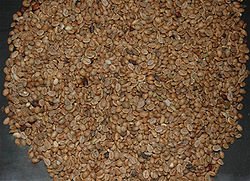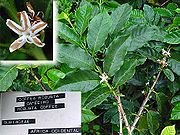Coffea Robusta
DDV CULINARY
Coffea canephora (Robusta Coffee; syn.Coffea robusta) is a species of coffee which has its origins in western Africa. It is grown mostly in Africa and Brazil, where it is often called Conillon. It is also grown in Southeast Asia where French colonists introduced it in the late 19th century. In recent years Vietnam, which only produces robusta, has surpassed Brazil, India, and Indonesia to become the world's single largest exporter. Approximately one third of the coffee produced in the world is robusta. Canephora is easier to care for than the other major species of coffee, Coffea arabica, and, because of this, is cheaper to produce. Since arabica beans are considered superior, robusta is usually limited to lower grade coffee blends as a filler. It is however often included in instant coffee, and in espresso blends to promote the formation of "crema". Robusta has about twice as much caffeine as arabica. Description
Unroasted coffee (Coffea canephora) beans
Coffea canephora grew indigenously in Western and Central Africa. It was not recognized as a species of Coffea until the 18th century, about a hundred years after Coffea arabica. The plant has a shallow root system and grows as a robust tree or shrub to about 10 metres. It flowers irregularly, taking about 10 – 11 months for cherries to ripen, producing oval shaped beans. The robusta plant has a greater crop yield than that of Coffea arabica and is less susceptible to pests and disease, possibly due to the higher caffeine content. Once roasted, Coffea canephora (Robusta) tends to deliver a distinctive earthy/burnt rubber flavour, usually with more bitterness than Coffea arabica. This powerful flavour can be desirable in a blend to give it perceived "strength" and "finish", noticeably in the Italia coffee culture. This article is licensed under the GNU Free Document LicenseIt uses material from Wikipedia. |
